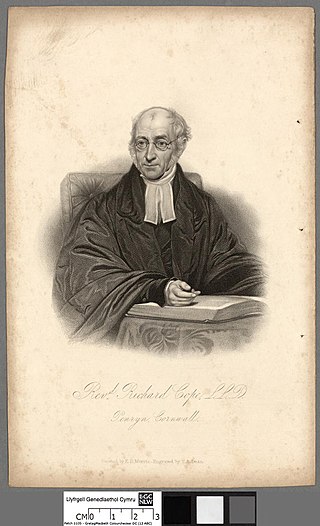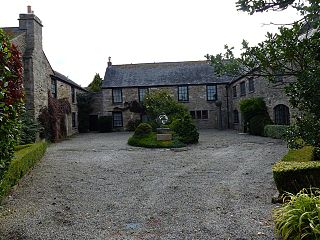Further reading
- Gale, Theophilus. (1671). The life and death of Thomas Tregosse late minister of the Gospel at Milar and Mabe in Cornwal: With his character, and some letters of his, not long before his death. London: s.n.
Thomas Tregosse | |
|---|---|
| Title | Reverend |
| Personal | |
| Born | c. 1600s |
| Died | c. 1670-71 Penryn, England |
| Resting place | Mabe, England |
| Religion | Puritan |
| Nationality | English |
| School | Exeter College, Oxford |
| Senior posting | |
| Period in office | 17th century |
| Ordination | 1657 |
| Post | Vicar, Mylor and Mabe, England |
Rev. Thomas Tregosse (alternate spellings: Tregrosse, [1] Tregoss, [2] Tregoose [3] ) (c. 17th century, St Ives, England - c. 1670-71, Penryn, England) of Cornwall was a Puritan minister [4] and vicar of the Rebellion period who was silenced for being a Nonconformist. [1]
He was born in St Ives, the son of William Tregosse. [5] He received his BA from Exeter College of Oxford University in 1655.
After taking Holy Orders, he preached for two years as an English Presbyterian minister at St. Ives. [6] In October 1659, he was instituted as vicar in Mylor and Mabe, and ejected 24 August 1662 under the Act of Uniformity for being a nonconformist. [7] According to Miss Susan Gay's Falmouth chronology, Tregosse formed an Independent Congregation in Falmouth in 1662. [8] At the first congregation at the Congregational Sunday School, Falmouth was gathered by the Reverend Mr. Tregoss. [6] After preaching to this family and neighbours, Falmouth was jailed for three months. [9]
In 1663, he preached privately at Budock. For preaching at the Church of Saint Laud, Mabe, he was again jailed for three months at Launceston gaol (jail). After his release, he preached again at the same church, and was subsequently imprisoned again. [9] Under the Conventicle Act 1664 non-Anglican services were only permitted in private homes, limited to members of the household and no more than five others. [10] Tregosse's imprisonment for holding a Conventicle at Budock is noted in "The Episcopal Returns of 1665-6" section of the Congregational Historical Society's Transactions. [11] After his fourth time in custody, he was set free September 1667 by special order of King Charles. He was jailed again in 1669 for preaching privately in a house at Great Torrington. In his later years, he preached on Sundays, Tuesdays, and Thursdays. [12]
Tregosse married Margaret Sparnan of Gwynier in 1658, and had at least one child, a son, the Rev. James Tregoss. [6]
Though Tregosse was committed to Launceston Gaol on multiple occasions, Wesley bestowed high praises upon Tregosse a century later. [6]
Tregosse died in Penryn. Different sources place his date of death at different years in the 1670s: 18 January 1670, [1] January 1672, [6] 18 January 1673, [12] or even 18 January 1679. [13] However, Theophilus Gale's biography, The life and death of Thomas Tregosse late minister of the Gospel at Milar and Mabe in Cornwal [sic]: With his character, and some letters of his, not long before his death, published in 1671, makes the year of death likely to be 1671 or earlier. [13]
Flushing is a coastal village in the civil parish of Mylor, west Cornwall, UK. It is 3 miles (5 km) east of Penryn and 10 miles (16 km) south of Truro. It faces Falmouth across the Penryn River, an arm of the Carrick Roads. The village is known for its yearly Regatta week in July.

Penryn is a civil parish and town in west Cornwall, England, United Kingdom. It is on the Penryn River about 1 mile (1.6 km) northwest of Falmouth. The population was 7,166 in the 2001 census and had been reduced to 6,812 in the 2011 census, a drop of more than 300 people across the ten-year time gap. There are two electoral wards covering Penryn: 'Penryn East and Mylor' and 'Penryn West'. The total population of both wards in the 2011 census was 9,790.

Theophilus Gale (1628–1678) was an English educationalist, nonconformist and theologian of dissent.

The hundreds of Cornwall were administrative divisions or Shires (hundreds) into which Cornwall, the present day administrative county of England, in the United Kingdom, was divided between c. 925 and 1894, when they were replaced with local government districts.

Budock Water is a village and former manor in the civil parish of Budock, Cornwall, England, United Kingdom. The village is situated two miles (3 km) west of Falmouth.

Mylor is a civil parish in Cornwall, England, United Kingdom. It is situated approximately five miles north of Falmouth.

Sir William Lemon, 1st Baronet was a Member of Parliament for Cornish constituencies from 1770 to 1824, a total of 54 years.

Mabe is a village and civil parish in Cornwall, England, United Kingdom. The village is situated one mile (1.6 km) west of Penryn.
Penryn and Falmouth was the name of a constituency in Cornwall, England, UK, represented in the House of Commons of the Parliament of the United Kingdom from 1832 until 1950. From 1832 to 1918 it was a parliamentary borough, initially returning two Members of Parliament (MPs), elected by the bloc vote system.
Penryn was a parliamentary borough in Cornwall, which elected two Members of Parliament (MPs) to the House of Commons of England from 1553 until 1707, to the House of Commons of Great Britain from 1707 to 1800, and finally to the House of Commons of the United Kingdom from 1801 to 1832. Elections were held using the bloc vote system.

The Church of Saint Laudus is an active parish church in Mabe, Cornwall, England, UK, originally built in the 15th century and dedicated to the sixth-century Saint Laudus of Coutances. It is part of the Church of England Diocese of Truro. Struck by lightning in the 19th century, much of it had to be rebuilt, though parts of the original church remain. It has been a Grade II* listed building since 10 July 1957.

Richard Cope (1776–1856) was an English congregationalist minister and religious writer.

Arwenack is a historic manor on the site of what is today the town of Falmouth, Cornwall, England, United Kingdom. Historically in the parish of St Budock, it was partly destroyed in 1646, and only a remnant survives today. It was long held by the Killigrew family, which was responsible for the development of the town of Falmouth, Sir Peter Killigrew, MP, having received a royal charter for its foundation in 1661.

Presented below is an alphabetical index of articles related to Cornwall:
Thomas Tregosse.
Tregosse.